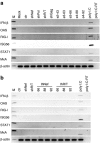Combinatorial RNAi against HIV-1 using extended short hairpin RNAs
- PMID: 19672247
- PMCID: PMC2835024
- DOI: 10.1038/mt.2009.176
Combinatorial RNAi against HIV-1 using extended short hairpin RNAs
Abstract
RNA interference (RNAi) is a widely used gene suppression tool that holds great promise as a novel antiviral approach. However, for error-prone viruses including human immunodeficiency virus type 1(HIV-1), a combinatorial approach against multiple conserved sequences is required to prevent the emergence of RNAi-resistant escape viruses. Previously, we constructed extended short hairpin RNAs (e-shRNAs) that encode two potent small interfering RNAs (siRNAs) (e2-shRNAs). We showed that a minimal hairpin stem length of 43 base pairs (bp) is needed to obtain two functional siRNAs. In this study, we elaborated on the e2-shRNA design to make e-shRNAs encoding three or four antiviral siRNAs. We demonstrate that siRNA production and the antiviral effect is optimal for e3-shRNA of 66 bp. Further extension of the hairpin stem results in a loss of RNAi activity. The same was observed for long hairpin RNAs (lhRNAs) that target consecutive HIV-1 sequences. Importantly, we show that HIV-1 replication is durably inhibited in T cells stably transduced with a lentiviral vector containing the e3-shRNA expression cassette. These results show that e-shRNAs can be used as a combinatorial RNAi approach to target error-prone viruses.
Figures








Similar articles
-
Design of extended short hairpin RNAs for HIV-1 inhibition.Nucleic Acids Res. 2007;35(17):5683-93. doi: 10.1093/nar/gkm596. Epub 2007 Aug 21. Nucleic Acids Res. 2007. PMID: 17715143 Free PMC article.
-
The inhibitory efficacy of RNA POL III-expressed long hairpin RNAs targeted to untranslated regions of the HIV-1 5' long terminal repeat.Oligonucleotides. 2007 Winter;17(4):419-31. doi: 10.1089/oli.2007.0095. Oligonucleotides. 2007. PMID: 17896874
-
The efficacy of generating three independent anti-HIV-1 siRNAs from a single U6 RNA Pol III-expressed long hairpin RNA.PLoS One. 2008 Jul 2;3(7):e2602. doi: 10.1371/journal.pone.0002602. PLoS One. 2008. PMID: 18596982 Free PMC article.
-
Lentiviral delivery of RNAi effectors against HIV-1.Curr Top Med Chem. 2009;9(12):1130-43. doi: 10.2174/156802609789630866. Curr Top Med Chem. 2009. PMID: 19860713 Review.
-
RNA-interference-based gene therapy approaches to HIV type-1 treatment: tackling the hurdles from bench to bedside.Antivir Chem Chemother. 2009;19(6):221-33. doi: 10.1177/095632020901900602. Antivir Chem Chemother. 2009. PMID: 19641231 Review.
Cited by
-
Molecular characteristics and efficacy of 16D10 siRNAs in inhibiting root-knot nematode infection in transgenic grape hairy roots.PLoS One. 2013 Jul 16;8(7):e69463. doi: 10.1371/journal.pone.0069463. Print 2013. PLoS One. 2013. PMID: 23874962 Free PMC article.
-
Multiple shRNA combinations for near-complete coverage of all HIV-1 strains.AIDS Res Ther. 2011 Jan 13;8(1):1. doi: 10.1186/1742-6405-8-1. AIDS Res Ther. 2011. PMID: 21226969 Free PMC article.
-
RNA-Based Therapeutics: From Antisense Oligonucleotides to miRNAs.Cells. 2020 Jan 7;9(1):137. doi: 10.3390/cells9010137. Cells. 2020. PMID: 31936122 Free PMC article. Review.
-
RNA interference for improving the outcome of islet transplantation.Adv Drug Deliv Rev. 2011 Jan-Feb;63(1-2):47-68. doi: 10.1016/j.addr.2010.11.003. Epub 2010 Dec 13. Adv Drug Deliv Rev. 2011. PMID: 21156190 Free PMC article. Review.
-
Combining RNA Interference and RIG-I Activation to Inhibit Hepatitis E Virus Replication.Viruses. 2024 Aug 29;16(9):1378. doi: 10.3390/v16091378. Viruses. 2024. PMID: 39339854 Free PMC article.
References
-
- Fire A, Xu S, Montgomery MK, Kostas SA, Driver SE., and , Mello CC. Potent and specific genetic interference by double-stranded RNA in Caenorhabditis elegans. Nature. 1998;391:806–811. - PubMed
-
- Meister G., and , Tuschl T. Mechanisms of gene silencing by double-stranded RNA. Nature. 2004;431:343–349. - PubMed
-
- Brummelkamp TR, Bernards R., and , Agami R. A system for stable expression of short interfering RNAs in mammalian cells. Science. 2002;296:550–553. - PubMed
Publication types
MeSH terms
Substances
LinkOut - more resources
Full Text Sources
Other Literature Sources

